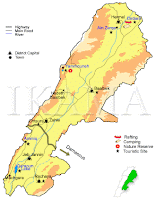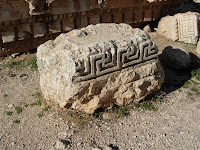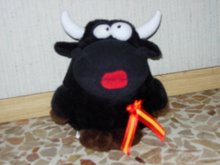
The road from Beirut to Chouf was obviously hitted by bombs, and here you can see a temporary bridge built by french army (enlarge the second pic to see the detail of the 2-way bridge)


Beiteddine is the administrative center of Chouf, 50km far from Beirut, famous for its magnificent 19th century palace complex, with a style between traditional Arab and Italian baroque, as best craftsmen from Damascus and Aleppo as well as Italian architects were invited to adorn it. During the Lebanese civil war it has been heavily damaged. Today parts of the palace are open to the public while the rest is the official president's summer residence.

The palace hosts the Beiteddine Festival (fitted for 5,000 persons) every summer...unfortunately, not in 2006, and lot of music stars were guest in its magnificent square: Ricky Martin, Goran Bregovich, Fairuz, Marcel Khalife, Shakira, Ute Lemper, José Carreras, Chick Corea, Youssou N’Dour, UB40, Elton John and many many others

We had a break in a wonderful palace used as restaurant and hotel...it was really a pity to find out that the war made the area empty, no tourists at all, and keeping so, there's no good perspective for the future. This is a new "gift" of the war. But i'm here also to witness how beautiful is Lebanon and, if there was no tension in this period, it would be again one of the most charming place of the world. Funny note: at the Hotel's reception three men were enjoying an old comic movie broadcasted on a older TV...it reminded me when i was young and liked to see Totò's movies :)


Note the Star of David on the door, which is just a geometric layout very used by craftmen to symobilze the divine perfection.


After a fast "pit-stop" to have a typical lebanese lunch of the mountains (please don't blame at me if i like so much the lebanese cuisine :-) )which was very heavy but so so tasty and yummy (i suggest a cream of onions, it looks like hommous or mutabal)

The lunch ends as usually with a cup of turkish coffee and the un-missable rite of bottom of the cup reading,

The trip continued laying up for a small town called Deir-al-Qamar (=Monastery of the Moon), 5km from Beiteddine, famous for having been the center of Arab literary tradition and as birth place of many well known personnalities, like presidents, artists, writers,etc. It displays very well the ancient Lebanese style in architecture.


Declared World Heritage by UNESCO, Deir-al-Qamar preserved its grand feudal architecture, old stepped streets, its stone houses with red roofs, and walled gardens. In the square itself is Fakhreddine's Mosque, constructed in 15th century; behind the mosque is a leather-worker's souq, which today houses modern shops, giving evidence of the importance of the village in silk manifacturing. Nearby there is the synagogue (yes, a synagogue!)built in the 17th century to serve the local Jewish population.



Look this pic: it shows a fountain in the courtyard; my architect friend explained me that the fountains were often built not in the centre but rather shifted to the right side, where there was the living area of men. The aim was to (unconsciously) appeal the guests toward men area, thus avoiding to "disturb" women. Moreover, the sound of water was useful to "cover" men voices during their speach, in order not to be heard by women eheh

Church of Saidet at-Talle (Notre-dame de la Colline) is another example of how it's possible to , by respecting of traditions, history and culture. United we stand, together with our differences... Note: Padre Pio's image in the Chruch, they told me he's very respected in Lebanon too.


I like this photo, i have slightly modified it 'cause i think the ochre shows better the right union you can breath here, between modern ("Welcome 2006" lights on the top of a central building) and classic, between christian, muslim and jewish, between Shams (Sun) and Qamar (Moon), between day and night, day and life

Preparing labneh (for shankleesh?)

The "ambassador" of Italy in deir-al-qamar :-))

































